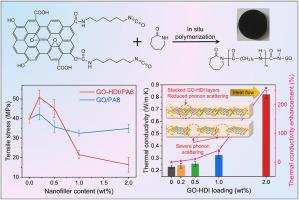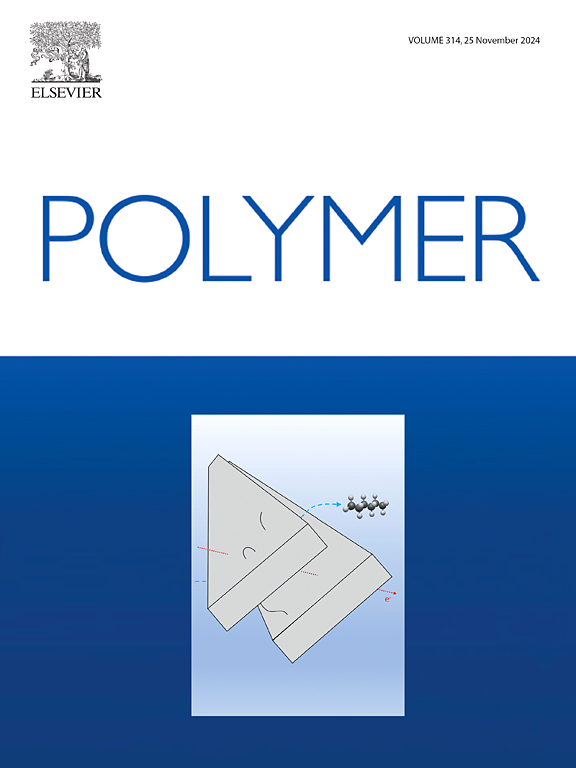Interface-engineered functionalized graphene oxide reinforced polyamide 6 composites with enhanced mechanical and thermal properties
IF 4.5
2区 化学
Q2 POLYMER SCIENCE
引用次数: 0
Abstract
The advancement of the automotive and mechanical industries has placed higher demands on the thermal conductivity of polyamide 6 (PA6). However, the weak interfacial bonding between graphene oxide (GO) and the PA6 matrix aggravates phonon scattering, which in turn increases interfacial thermal resistance and limits the improvement of composite thermal conductivity. To address this issue, hexamethylene diisocyanate (HDI) was employed as an interfacial modifier, and GO-HDI/PA6 composites featuring strong covalent bonding at the nanofiller/matrix interface were fabricated via anionic ring-opening polymerization. As a result, incorporating a low content of GO-HDI could significantly enhance both the thermal conductivity and tensile strength of the composites. At 2 wt% GO-HDI, the thermal conductivity of the PA6 composite increased to 0.821 W/m·K, representing a 258.5 % improvement compared to neat PA6. Moreover, with only 0.2 wt% GO-HDI, the tensile strength of the composite improved by 27.9 %, reaching 50.9 MPa. The outstanding thermal conductivity and mechanical performance were attributed to the uniform dispersion of the nanofillers and their strong interfacial bonding with the matrix, which were further verified by scanning electron microscopy (SEM) and Fourier transform infrared spectroscopy (FTIR) analyses. This composite holds significant application potential in various fields that demand stringent thermal management and structural performance requirements.


界面工程功能化氧化石墨烯增强聚酰胺6复合材料,具有增强的机械和热性能
汽车和机械工业的发展对聚酰胺6 (PA6)的导热性能提出了更高的要求。然而,氧化石墨烯(GO)与PA6基体之间的弱界面键合加剧了声子散射,从而增加了界面热阻,限制了复合材料导热性的提高。为了解决这一问题,采用六亚甲基二异氰酸酯(HDI)作为界面改性剂,通过阴离子开环聚合制备了在纳米填料/基体界面上具有强共价键的GO-HDI/PA6复合材料。因此,加入低含量的GO-HDI可以显著提高复合材料的导热性和抗拉强度。当GO-HDI为2 wt%时,PA6复合材料的导热系数增加到0.821 W/m·K,与纯PA6相比提高了258.5%。此外,当GO-HDI含量为0.2 wt%时,复合材料的抗拉强度提高了27.9%,达到50.9 MPa。扫描电镜(SEM)和傅里叶红外光谱(FTIR)分析进一步验证了纳米填料的优异导热性和力学性能,认为其分散均匀,与基体界面结合强。这种复合材料在各种需要严格热管理和结构性能要求的领域具有重要的应用潜力。
本文章由计算机程序翻译,如有差异,请以英文原文为准。
求助全文
约1分钟内获得全文
求助全文
来源期刊

Polymer
化学-高分子科学
CiteScore
7.90
自引率
8.70%
发文量
959
审稿时长
32 days
期刊介绍:
Polymer is an interdisciplinary journal dedicated to publishing innovative and significant advances in Polymer Physics, Chemistry and Technology. We welcome submissions on polymer hybrids, nanocomposites, characterisation and self-assembly. Polymer also publishes work on the technological application of polymers in energy and optoelectronics.
The main scope is covered but not limited to the following core areas:
Polymer Materials
Nanocomposites and hybrid nanomaterials
Polymer blends, films, fibres, networks and porous materials
Physical Characterization
Characterisation, modelling and simulation* of molecular and materials properties in bulk, solution, and thin films
Polymer Engineering
Advanced multiscale processing methods
Polymer Synthesis, Modification and Self-assembly
Including designer polymer architectures, mechanisms and kinetics, and supramolecular polymerization
Technological Applications
Polymers for energy generation and storage
Polymer membranes for separation technology
Polymers for opto- and microelectronics.
 求助内容:
求助内容: 应助结果提醒方式:
应助结果提醒方式:


